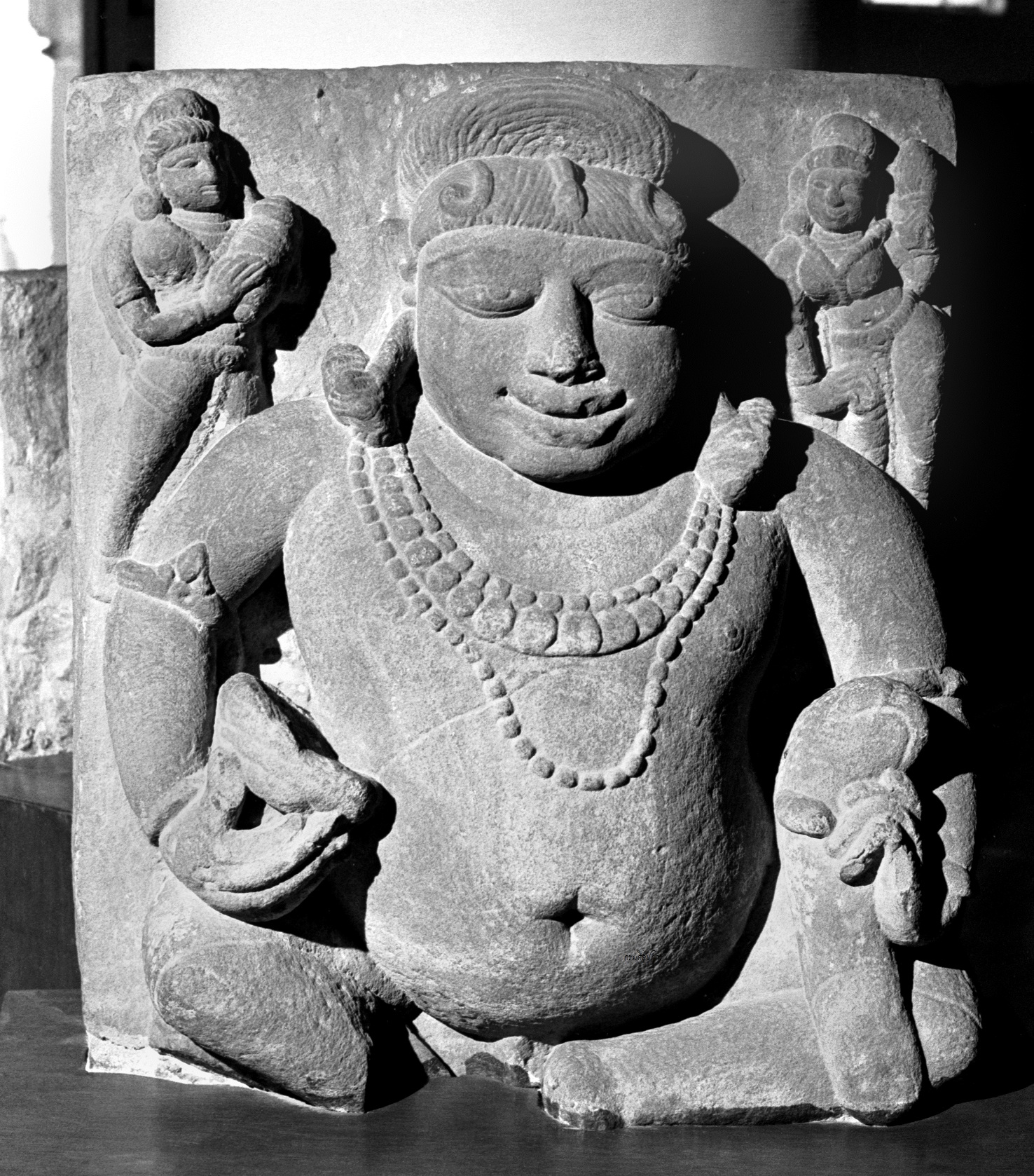
ในเทพปกรนัม (คัมภีร์ปุราณะ) กล่าวว่า ยักษ์ถือกำเนิดจาก พระกัศยป (Kaśyapa) และนางขสา(Khasā) ธิดาองค์หนึ่งของพระทักษะ (Dakṣa)
เป็นมารดาของเหล่ายักษ์และรากษส หรือกล่าวว่าเป็นบุตรของ ฤๅษีปุลัสตยะ (Pulastya) พระประชาบดี อันเป็น ๑ ใน ๑๐ บุตรที่เกิดจากใจ หรือมนัสของพระพรหม (มานัสบุตร-Mānasaputra) จัดเป็นบริวารของท้าวกุเวร (Kuvera) เทพเจ้าแห่งความมั่งคั่งร่ำรวย และเป็นเทพผู้คุ้มครองโลก (โลกบาล-Lokapala) ประจำทิศอุดร (ทิศเหนือ) ตรงกับท้าวเวสวัณ (Vesavaṇa) หนึ่งในจตุโลกบาล ในพระพุทธศาสนาฝ่ายเถรวาท และชัมภละ (Jambhala) เทพแห่งความมั่งคั่ง ในพระพุทธศาสนาฝ่ายมหายาน
ท้าวกุเวร, กุเพร หรือกุเพรัน (Kuvera,Kubera, Kuberan) ในสมัยพระเวทเป็นราชาแห่งจิตวิญญาณชั่วร้ายลักษณะเป็นยักษ์แคระ ถือเป็นเทพแห่งโจรและการลักทรัพย์ อาศัยอยู่ตามป่าเขา ถ้ำลึก คอยเฝ้าอัญมณี และทรัพย์สมบัติ พวกโจรนิยมบูชาท้าวกุเวร เพื่อให้ช่วยเหลือในการปล้น คอยปกป้องคุ้มภัยจากภูตผีปีศาจ และคอยเฝ้าทรัพย์สมบัติ ต่อมาในคัมภีร์ปุราณะและมหากาพย์ มีสถานะเป็นเทพ กล่าวว่าเป็นโอรสของ วิศรว (Viśrava) หลานของฤๅษีปุลัสตยะ (Pulastya) มารดาคือ นางอิลวิลา (Ilavilā) อีกนัยหนึ่งว่าเป็นโอรสของปุลัสตยะ เป็นพี่ชายต่างมารดาของราวณะ (ทศกัณฐ์) มีกำเนิดเป็นยักษ์ พระพรหมประทานชื่อว่า ไวศรวัน (Vaiśravaṇa) หมายถึง เกิดแต่วิศรว เนื่องจากมีร่างกายไม่งดงามจึงมีฉายาว่า “กุเวร” (Kubera) แปลว่า ตัวขี้ริ้ว ได้บำเพ็ญตบะจนเป็นที่โปรดปรานของพระศิวะจึงได้รับพรให้เป็นเจ้าแห่งทรัพย์ทั้งหลาย และได้เป็นเทพโลกบาลประจำทิศเหนือเดิมปกครองกรุงลงกา ต่อมาราวณะได้มาทำสงครามและแย่งเมืองลงกาไป พระศิวะจึงทรงมอบเมืองใหม่ให้ ชื่อว่า อลกา (Alakā) เรียกอีกว่า ประภา (Prabhā) วสุธรา (Vasudharā) หรือ วสุสถลี (Vasusthalī) อยู่บนยอดเขาคันธมัณฑนะ (Gandhamaṇḍana) บางแห่งกล่าวว่าอยู่บนเขาเหมกูฏ (Hemakūṭa) หรืออยู่บนเขาไกลาส (Kailāsa) ซึ่งสัมพันธ์กับการเป็นเทพผู้พิทักษ์ประจำทิศเหนือ
รูปเคารพของท้าวกุเวร มักทำเป็นรูปคนแคระ ผิวกายขาว พระอุทรใหญ่ กายประดับด้วยอาภรณ์ต่าง ๆ มุทราประจำพระองค์คือ ปางประทานอภัย (อภยมุทรา-abhayamudrā) และ ปางประทานพร (วรทมุทรา-Varadamudrā) พระหัตถ์ถือคทา ทับทิม ผลมะนาว (ชัมภีระ-Jambīra) หม้อน้ำ (กมัณฑลุ-kamaṇḍalu) ภาชนะใส่ของมีค่า ถุงเงิน และพังพอน แสดงชัยชนะเหนือนาคผู้รักษาทรัพย์ใต้ดิน มักปรากฏอยู่บริเวณทางเข้าศาสนสถาน เป็นการอำนวยพรแก่ศาสนิกชน
According to mythology (Purana scriptures), yaksha was born to Kashyapa and Khasa, one of the daughters of Daksha and the mother of yakshas and rakshasas. Also, some said that yaksha was the son of the Rishi Pulastya, Prajapati. Yaksha is one of the ten sons born from the mind or manat of Brahma (Manasaputra). Yaksha is classified as the attendant of Kubera, god of wealth and god who protects the world (Lokapala) in the North, the same as Vessavana, one of Caturlokapala (The Four Great Heavenly Kings) in Theravada Buddhism and Jambhala, the god of wealth in Mahayana Buddhism.
Kuvera, Kubera or Kuberan in the Vedic period was the king of evil spirits. His appearance was like a dwarf giant. He was considered as the god of thieves and robbers who lived in forests, deep caves, guarding gems and treasures. Thieves often worshipped Kubera as they believed he would assist them in robberies, protect them from demons and watch over their treatures. Later in the Purana scriptures and Epics, he had divine status as the son of Vishrava and the grandson of Rishi Pulastya. His mother was Ilavila. Some said he was the son of Pulastya and the half-brother of Ravana (Tosakanth). He was born as yaksha. Brahma named him ‘Vaishravana’ which means ‘Born to Vishrava’. Since his figure was unsightly, he was known by the name ‘Kubera’ which means ill-shaped body. He performed asceticism until he was favoured by Shiva. Therefore, he was blessed to be the lord of all wealth and the god of the world (Lokapala) of the North direction. Originally, he ruled the city of Lanka. Later, Ravana made war and occupied that city. Thus, Shiva provided a new city named Alaka for Kubera to rule. This city, also called Prabha, Vasudhara or Vasusthali, located on the top of Mount Gandhamadana. Some said it was on the hill of Hemakuta or on Mount Kailash which either had a location related to his being the guardian deity of the North direction.
Kubera is depicted as a dwarf with white body, large belly, adorned with various ornaments. His regular mudras (gestures) are dispelling fear (abhayamudra) and giving blessing (varadamudra). His hands hold a scepter, pomegranate, lemon (jambira), water pot (kamandalu), container of valuables, money bag and mongoose that symbolizes his victory over Naga, the guardian of underground treasures. He often appears at an entrance to religious places so as to give a blessing to religious people.
ภาพ: กุเวร ศิลปะอินเดียภาคเหนือพุทธศตวรรษที่ ๑๖ มีรูปเป็นคนแคระ ท้องใหญ่แสดงความอุดมสมบูรณ์ สวมเครื่องประดับเพชรพลอยและไข่มุก มือข้างหนึ่งถือภาชนะ ข้างหนึ่งถือพังพอนมีบริวารสตรีสองข้างถือหม้อบรรจุทรัพย์สินมีค่าและแส้จามร
เก็บรักษาในพิพิธภัณฑ์อัลลาฮาบัด รัฐอุตรประเทศ อินเดีย
ภาพจาก The Huntington Archive
ข้อมูล: สมุดภาพมรดกศิลปวัฒนธรรม เรื่อง ภูมิบริรักษ์ : ครุฑ ยักษ์ นาค








